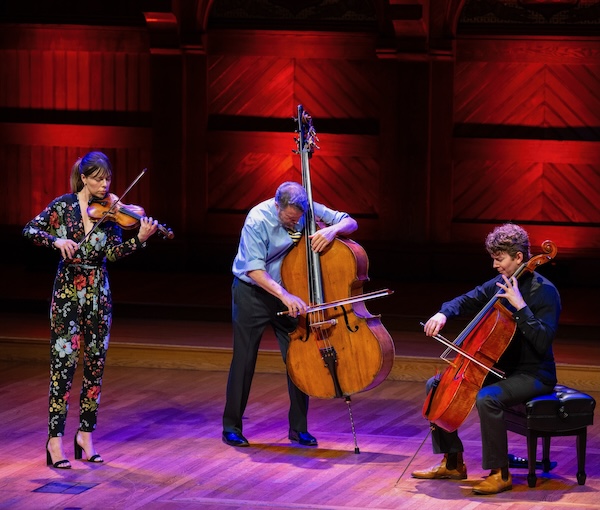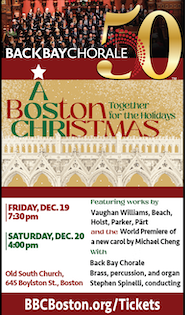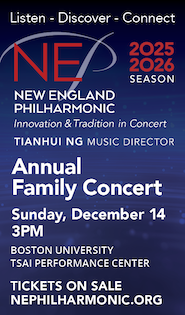Edgar Meyer and friends provide stellar advocacy for his music

Edgar Meyer, Tessa Lark and Joshua Roman performed Friday night at Sanders Theatre for the Celebrity Series. Photo: Robert Torres
Some composers—like John Adams, the author of The Dharma at Big Sur, Gnarly Buttons, and Slonimsky’s Earbox—can’t resist a catchy title. Edgar Meyer, on the other hand, seems to prefer keeping things simple.
His set of compositions for violin, cello, and double bass, for instance, are respectively called Trio 1986, Trio 1988, and New Trio (2024). But the lack of fancy designators doesn’t indicate a shortage of engaging musical ideas in any of them, as Friday night’s Celebrity Series-sponsored presentation of the triptych at Sanders Theatre demonstrated.
Take that first, nearly-40-year-old effort. As played by violinist Tessa Lark, cellist Joshua Roman, and Meyer—who, in addition to being an accomplished composer, is a celebrated double bass virtuoso—its folksy air and conversational aspect remain fresh and vital.
At some points, like in the third movement’s blend of hoedown-ish violin-and-cello exchanges, bluesy bass solos, and bent notes from all, the spirit is jocular and playful. At others, such as amid the second’s contrasts of undulating ostinatos and chorales, the mood turns contemplative.
In the score’s outer movements, things often get vigorous. The opening section’s pulsing introduction cedes way to episodes of neo-Appalachian fiddle music passed from violin to cello and bass, while the finale’s wild moto perpetuo is as brilliant a showcase for this instrumentation as any in the canon.
Friday’s reading, with its astonishingly unified articulations and attacks, was a model of character and style. Also, heart: the slow movement’s denouement offered a touching, beautifully balanced culmination of thematic ideas.
A similarly transcendent moment in the corresponding part of the 1988 trio was, unfortunately, marred by an exquisitely ill-timed cell phone going off, full volume, just as the music faded away. Before that exasperating, jangling lapse, though, Lark and Roman wove an enchantingly Bachian dialogue between their parts, as notable for its intensely soft dynamics as for its gently dancing aura.
In this middle trio’s rondo-like first movement, the collective brought rhythmic intensity to bear on the statements framing its pure, hymnlike refrain. Meantime, the jazzy scherzo included a spectacularly grooving duet between Lark and Meyer that earned the group a mid-performance ovation.
Though the finale doesn’t quite fit with the work’s first three movements—its drones, glissandos, and distortion pedal effects sound like they belong to a different piece—there was little to argue with in terms of the ensemble’s execution. Lark, for one, shredded her raw, earthy solos.
In more than a few ways, in fact, the second trio anticipates Meyer’s latest installment in the sequence.
Here, abstraction is the name of the game. The first movement is an often-crabbed and gritty study in rhythmic dissonance. Echoes of Stravinsky and, maybe, Adams emerge in its sometimes slithering, sometimes buzzing textures. In between comes balmy, weightless lyricism as a kind of relief. That doesn’t last, though: the score wraps up with another blistering perpetual motion.
The marvel of Friday’s account was twofold. On the one hand, there was the ensemble’s locked-in playing. Roman’s blissed-out take on his part in the finale was especially striking.
On the other, there was the easy confidence of Meyer’s compositional technique. While the earliest trio is never less than impressive and its sequel is perfectly fluent, the third moves with complete assurance and freedom between strongly varied stylistic reference points, harmonic and textural poles, and motivic ideas. If the artist’s imperative is to grow, Meyer has accomplished as much—and exceedingly well.
In that and more, he’s part of a larger tradition, as the night’s framing numbers by J. S. Bach subtly reminded. The Baroque master’s G-major Sonata for Viola da Gamba came over as a striking precursor to Meyer’s more recent undertakings: a singing, dancing, sometimes spunky reworking of musical ideas drawn from folk and popular traditions of his day. The group’s jam session-like account of its finale was particularly inviting.
Their encore of the same composer’s “Wachet auf, ruft uns die Stimme” was likewise fresh. Playing—as they did all night—from memory and with minimal vibrato, Lark, Roman, and Meyer imbued this favorite with a sweetness, direction, and conviction that summed up the night by calling to mind Beethoven’s inscription on the Missa solemnis: “From the heart, may it go back to the heart.”
Posted in Performances


